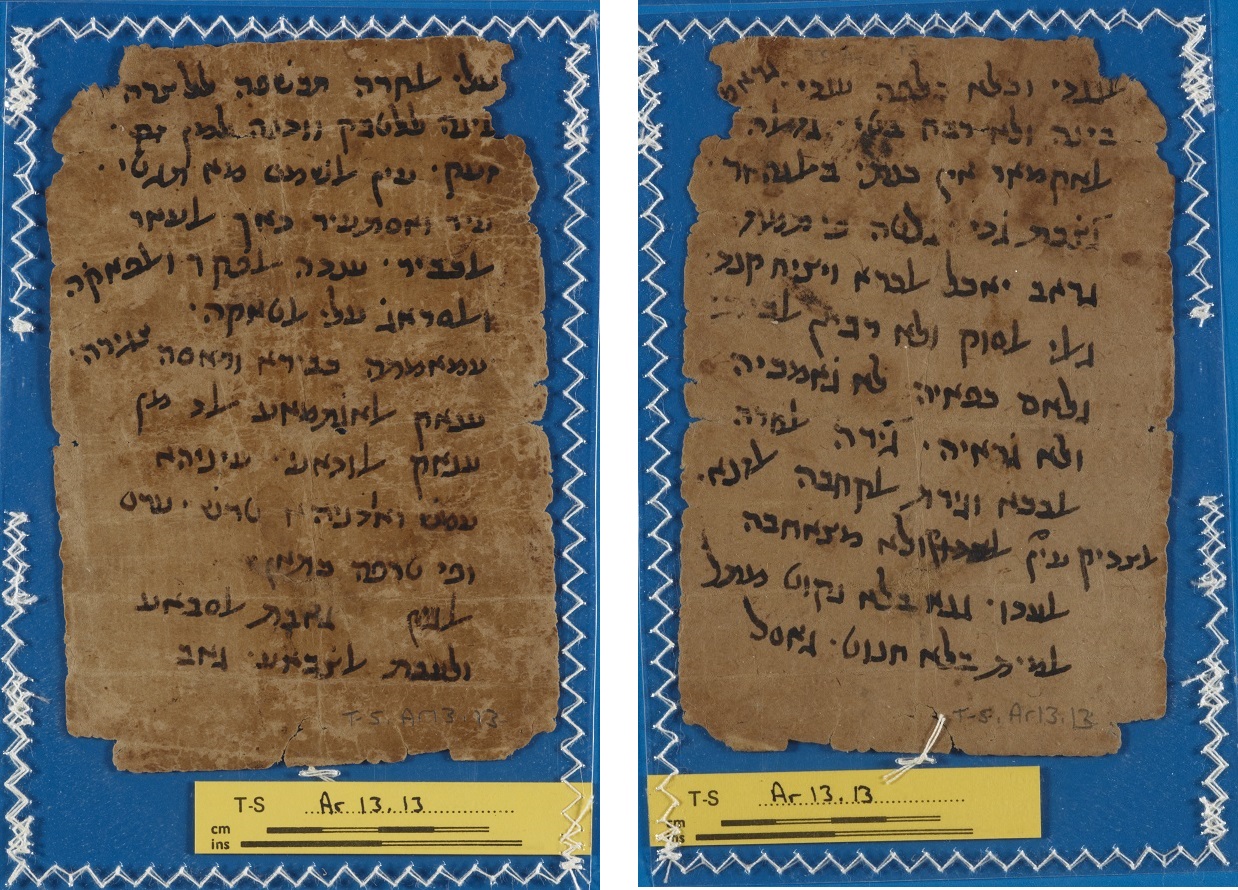From a lost book of Egyptian proverbs: T-S Ar.13.13[1]
Medieval and pre-modern Judaeo-Arabic manuscripts hold many works and fragments of popular literature. This includes folk tales and colloquial poetry (Zajal), which constitute a key feature in the Arabic literature preserved in the Cairo Genizah.
Aphorisms and proverbs freely circulated among Jewish communities in the medieval period. Nevertheless, most Genizah books and/or fragments that hold Arabic proverbs are written in Standard/Classical Arabic. From the medieval period comes the famous Judaeo-Arabic work by Rabbi Moshe ibn Ezra (c. 1055–1060) Kitāb al-Muḥāḍara wa al-Muḏākara. Arabic proverbs in the book, which number in their hundreds, reflect the integration of aphorisms as a significant element in the culture and literature at the time.[2] Another important book, Kitāb ad-durr al-manzūm, contains a large number of aphorisms and quotations, the majority derived from Sufi literature, though not written in Egyptian Arabic.[3] Avishur reflects on the unique formulation of proverbs in Iraqi Judaeo-Arabic, in which the aphorisms show a remarkable combination - half-Hebrew and half-Arabic.[4]
Unlike these important works of literature, the fragment under investigation holds a collection of Egyptian Arabic proverbs – some as yet unpublished - written in Hebrew script.[5] The single paper leaf contains a total number of 21 proverbs in Egyptian Arabic arranged in Arabic alphabetical order. The recto contains ten proverbs, in which the first word in each proverb has the initial Arabic letter ʿayn. The verso contains eleven proverbs beginning with ḡayn. Based on the style of the Hebrew script and the nature of the paper, it is likely that the fragment should be dated to the period between the 13th–15th centuries.
The comparison between the proverbs in this fragment and the known Arabic proverb collections and Arabic linguistic works by travellers and scholars reveals exciting results. The proverbs in the Genizah fragment T-S Ar.13.13 are quite similar to the collection found in Burckhardt’s 1875 work on Arabic proverbs.[6] However, the most crucial observation is that the fragment holds eight, or perhaps nine, proverbs that are only extant in our fragment; four of them start with the letter ʿayn, and the other four or five with ḡayn: to give an example:
T-S Ar.13.13 recto, line 1:
עלי אלחרה תכשׁפה ללצרה
على الحرّة تكشفه للصره.
ʿala al-ḥurra tikśifu lel-ṣurra[7]
For a virtuous woman undress (yourself) till the navel.

T-S Ar.13.13 recto T-S Ar.13.13 verso
T-S Ar.13.13 recto, line 13–verso, line 1:
גאב אלגנדי וכלא כלפה ענדי
غاب الجندي وخلا خلفه عندي.
ḡāb el-gundī we ḵallā ḵalafu ʿandī
The soldier went away and left his kids with me.
The fragment, although only consisting of a solitary leaf, shows how vital the Cairo Genizah is for the study of Egyptian Arabic and folklore literature. This fragment, and many like it, confirm the shared cultural heritage between Egyptian people at the time regardless of religious background or ethnicity. It is hoped that the study of Arabic literature preserved in the Cairo Genizah will receive the scholarly attention it deserves.
Footnotes
[1] I would like to thank Dr Ben Outhwaite for reading the draft and for his comments.
[2] In Judæo-Arabic culture in al-Andalus: Proceedings of the 13th Conference of the Society for Judaeo-Arabic Studies, Cordoba 2007, ed. Amir Ashur (Córdoba, Spain: CNERU - CSIC; Oriens Academics, 2013).
[3] In Giving a diamond: Essays in honor of Joseph Yahalom on the occasion of his seventieth birthday, ed. Joseph Yahalom, Naoya Katsumata and Wout J. van Bekkum, Études sur le judaïsme médiéval v. 49 (Leiden/Boston: Brill, 2011).
[4] Yitsḥaq. Avishur, “Hebrew and Arabic aphorisms half and half in two collections of folk tales in Judaeo-Arabic [Hebrew],” Yedaʻ-ʻam, 1995.
[5] A full article has been accepted for publication in the Journal of Islamic Manuscripts (Leiden: Brill), which explores the whole fragment and gives a Hebrew and Arabic transcription together with the translation and commentary.
[6] John Lewis Burckhardt, Arabic Proverbs: Manners and Customs of the Modern Egyptians, Illustrated from their Proverbial Sayings Current at Cairo (London: Quaritch, 1875).
[7] The transliteration is mine, and I have tried to follow modern Egyptian colloquial Arabic. It is possible that the real pronunciation might be different from what is provided here, especially as the Judaeo-Arabic text is not vocalized.
Cite this article
Ahmed, M. A. H. (2019). From a lost book of Egyptian proverbs: T-S Ar.13.13[1]. [Genizah Research Unit, Fragment of the Month, November 2019]. https://doi.org/10.17863/CAM.63286
If you enjoyed this Fragment of the Month, you can find others here.
Contact us: genizah@lib.cam.ac.uk
The manuscripts in this article are included in the Cambridge Digital Library. To see these and other items visit: https://cudl.lib.cam.ac.uk/
